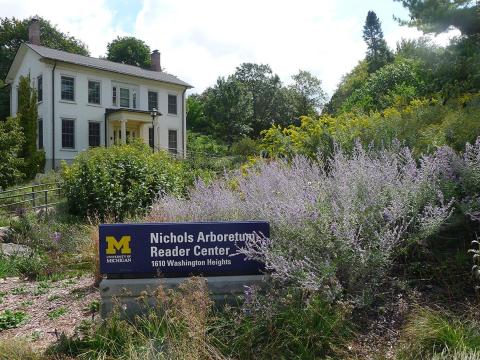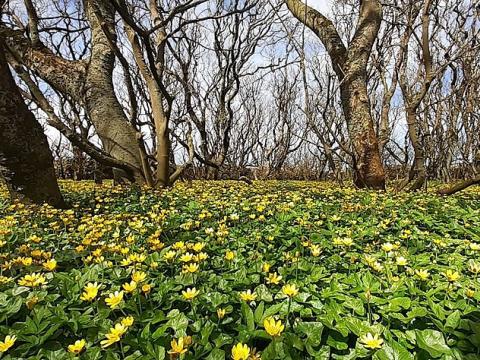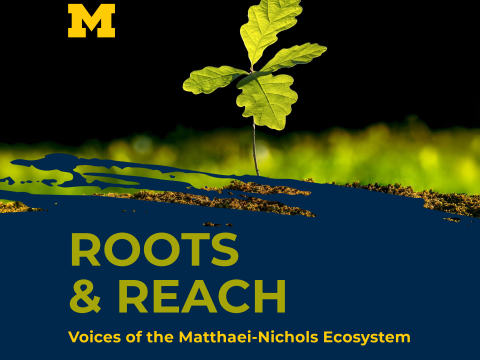Meet Calla
Calla Butler (she/her/hers) is a dedicated Native Plant Gardens Technician at Matthaei Botanical Gardens and Nichols Arboretum. Calla’s daily tasks encompass a variety of responsibilities, from planting and removing invasives to collecting seeds and working alongside volunteers.
But what truly sets her apart is her unwavering passion for native plants and the natural world. In this interview, Calla takes us on her journey, from her early days of gardening at home to working in her family’s native plant nursery outside of Philadelphia, while offering valuable advice to individuals eager to incorporate native plants into their environments.
Tell us about what you do at Matthaei Botanical Gardens and Nichols Arboretum.
I spend the majority of my time working in our Great Lakes Gardens, which are coincidentally celebrating a 10 year anniversary this year! On an average day I have a mix of things to work on in the gardens including planting, removing invasives, collecting seeds, and working with volunteers.
Can you tell us a little bit about your journey? What motivated you to pursue a career or passion in this field?
I grew up gardening at home and eventually started working in my family’s native plant nursery outside of Philadelphia. I remember one day at the nursery seeing a Hickory Horned Devil caterpillar (I highly recommend looking up a picture of this caterpillar because it is wild looking!) that had completely defoliated one of our American hornbeam trees.
Watching and experiencing how native plants attract so much wildlife is definitely where my interest and passion originated.
Can you share a little about how native plants differ from non-native species, and why are they essential to the ecosystem?
There’s a lot of information available on this topic! One interpretation is that native plants occur naturally (without human introduction) in an ecosystem/region where they have evolved over a long period of time. Native plants are required by the wildlife that evolved alongside them for habitat and as a food source.
Many insects are specialists, meaning they require specific plant species for food. One example most people are familiar with is the Monarch butterfly. The Monarch caterpillar will only eat milkweeds. If you remove milkweeds from your landscape the Monarch butterfly cannot reproduce. That’s just one example of why native plants are so important!
What advice do you have for individuals or communities interested in incorporating native plants into their environments?
This is a great question! There’s so much information out there about native plants and why you should use them, that it can be intimidating if you are new to gardening. I would suggest starting small, consider adding 3-5 native perennials a year to your garden or patio. You would be surprised at how much of a difference one native plant can make! If you don’t have a yard that doesn’t mean you can have native plants. Many native perennials can be grown in a container (as long as you remember to water)!
Here are three great native plants you could start with:
- Milkweed
Asclepias tuberosa in a well-drained sunny spot or Asclepias incarnata in average to wet soils in sun/part sun. Milkweed is the host plant for the Monarch butterfly! - Columbine
Aquilegia canadensis tolerates shade to full sun and dry to average soils. The flower is very ornamental and attracts hummingbirds. - Liatris
Liatris spicata likes part sun/sun and medium to wet soils. This is currently blooming in our lakeplain prairie in the Great Lakes Gardens and it attracts a ton of pollinators! If you have dry soil you can substitute Liatris scariosa, which is equally as showy!
If you are looking to connect with a community of like-minded people check your local garden clubs or join a native plant-focused group like Wild Ones.
I know we shouldn’t have favorites, but are there any specific native plant species that you feel particularly passionate about?
This is an impossible question!!! If I had to pick one it would be Swamp milkweed, Asclepias incarnata. The flower is bright to pale pink and very fragrant. It’s a host plant for the Monarch butterfly. You can usually find a few caterpillars on it in summer (check the underside of the leaves) and lots of other pollinators visit the flower.
Runner up would be the Cardinal flower, Lobelia cardinalis, which is blooming in our Wet Woodland Garden in the Great Lakes Gardens. It’s the ultimate hummingbird plant and the flower is neon red!





